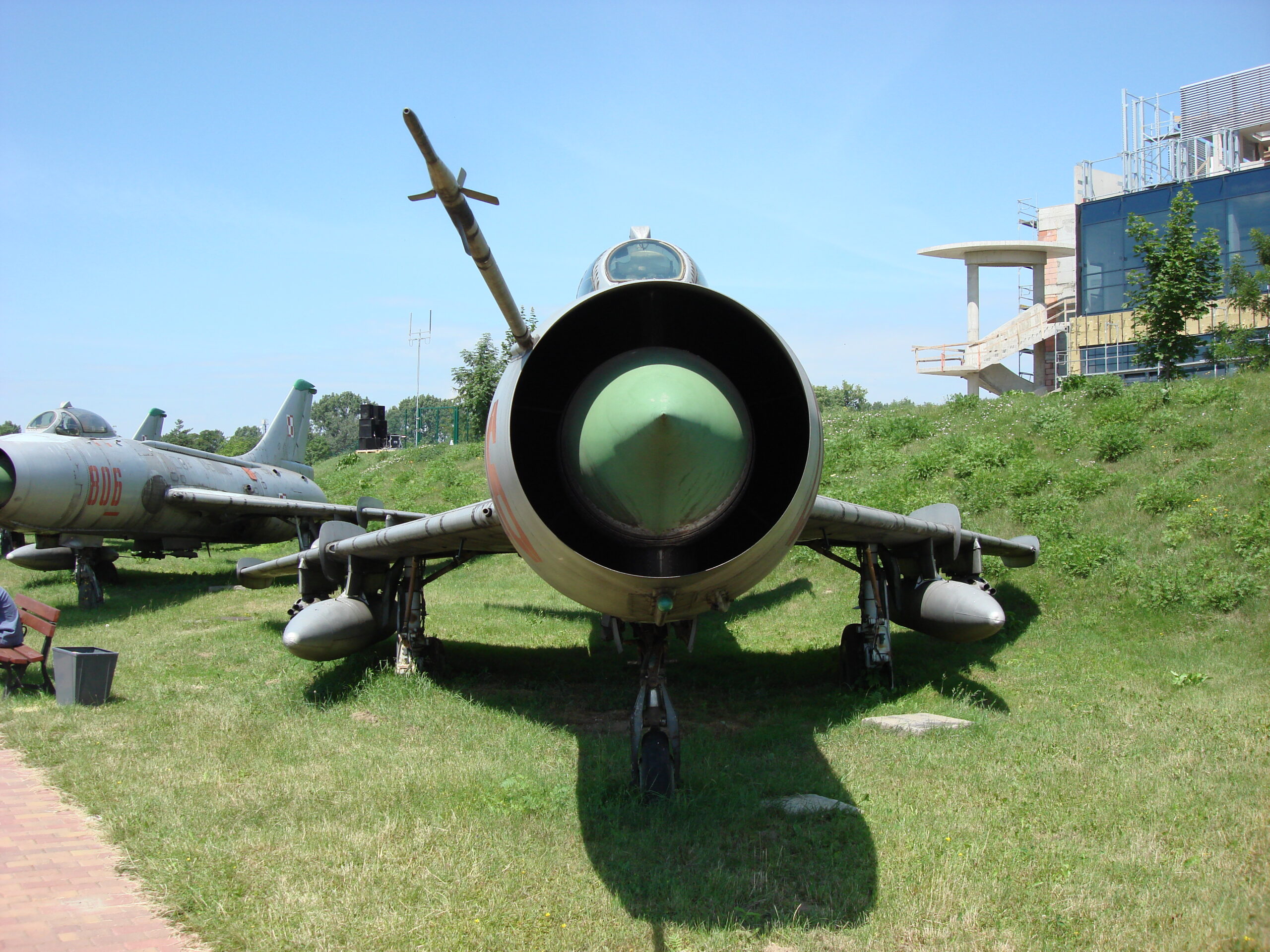Kraków 2007-07-24
197 Section 1964-06-01
OKB Suchoj PL Su-7 B (BM, BKŁ, U). Construction
Hypersonic close combat support aircraft and nuclear strikes.
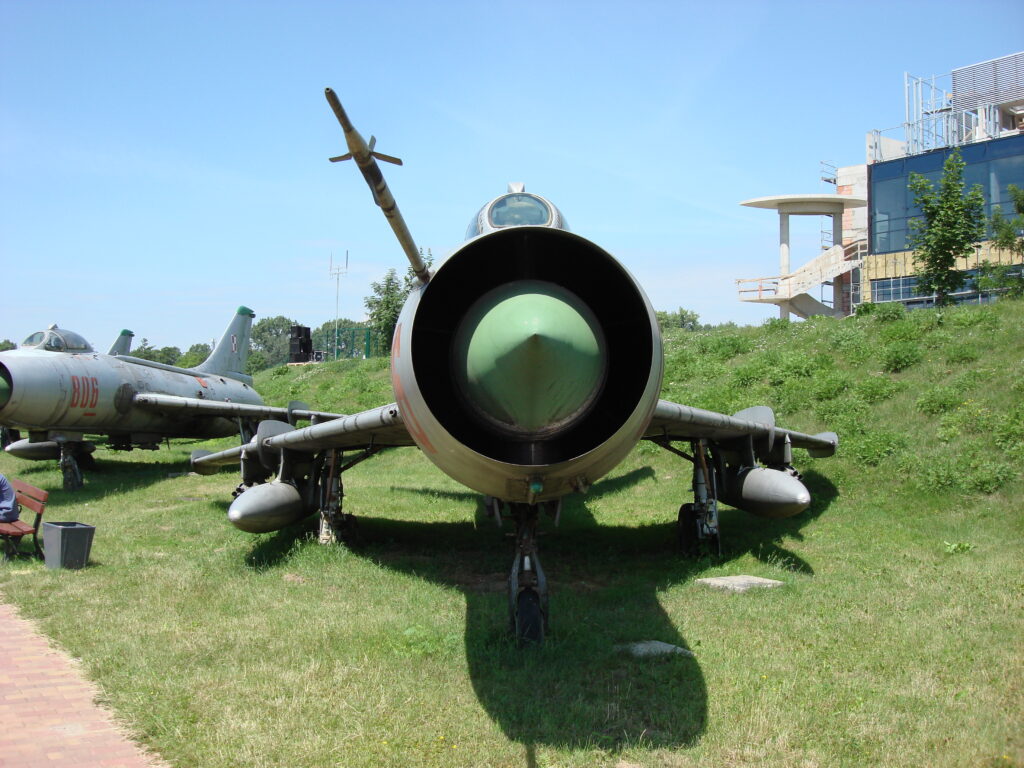
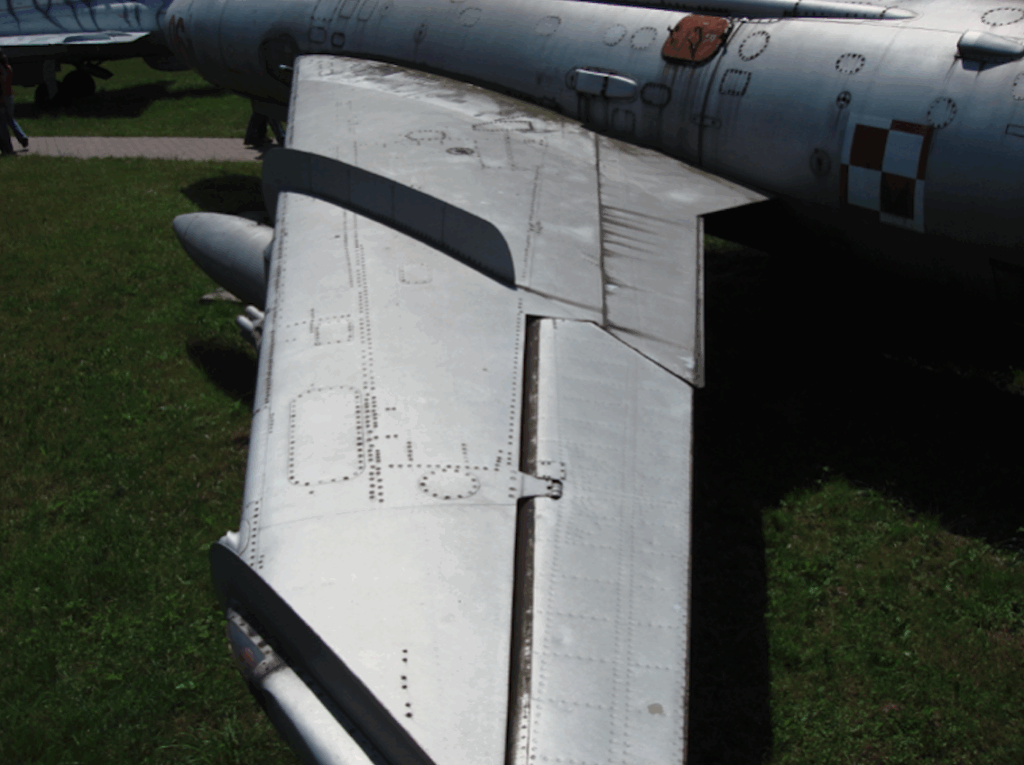
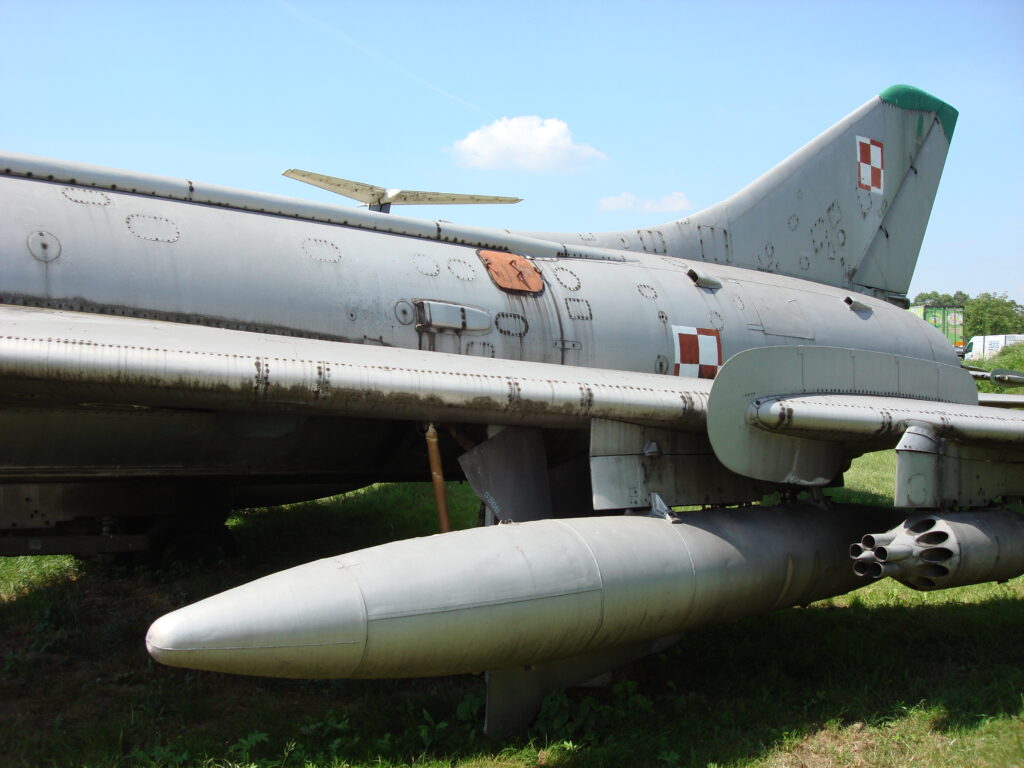
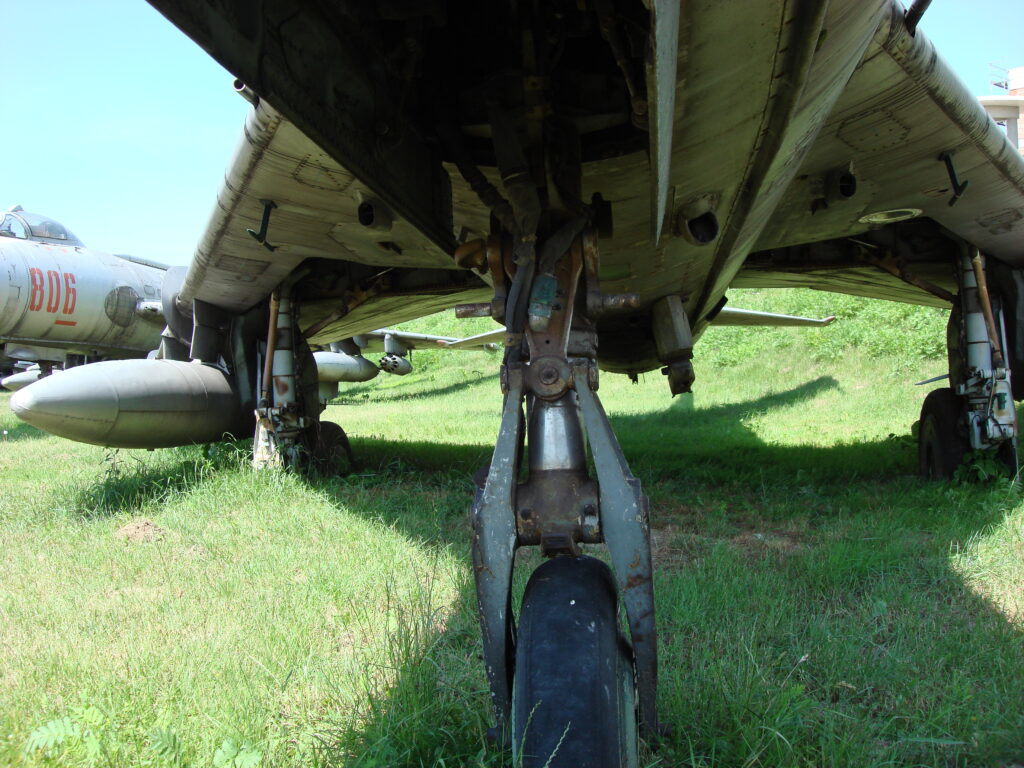
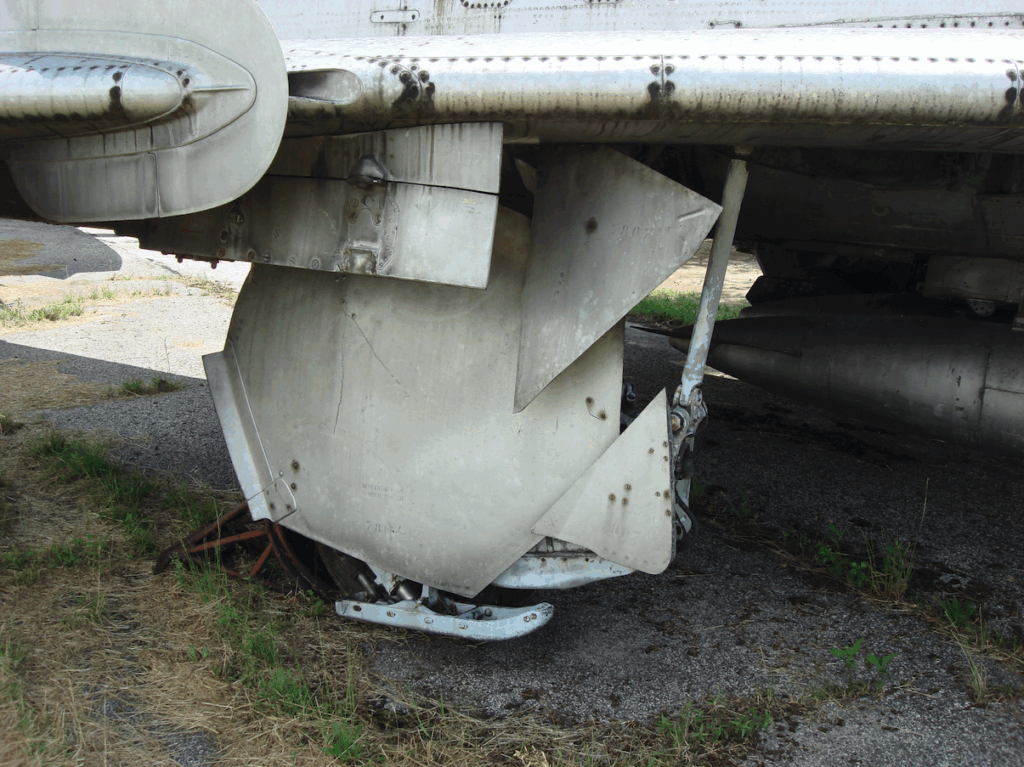
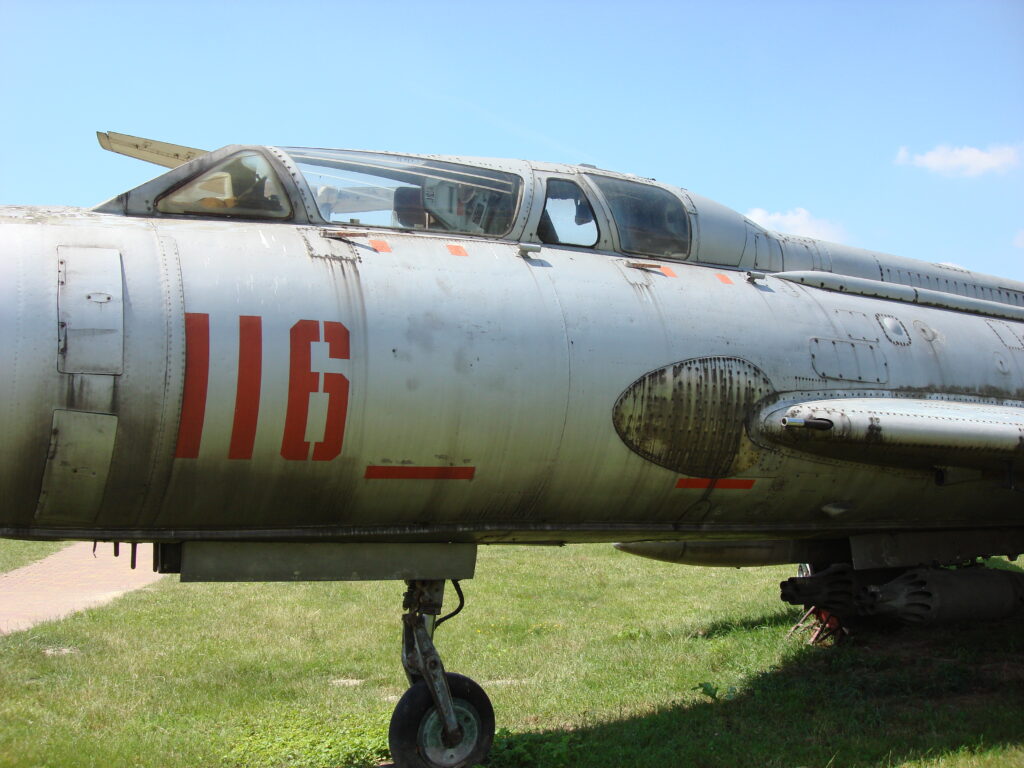
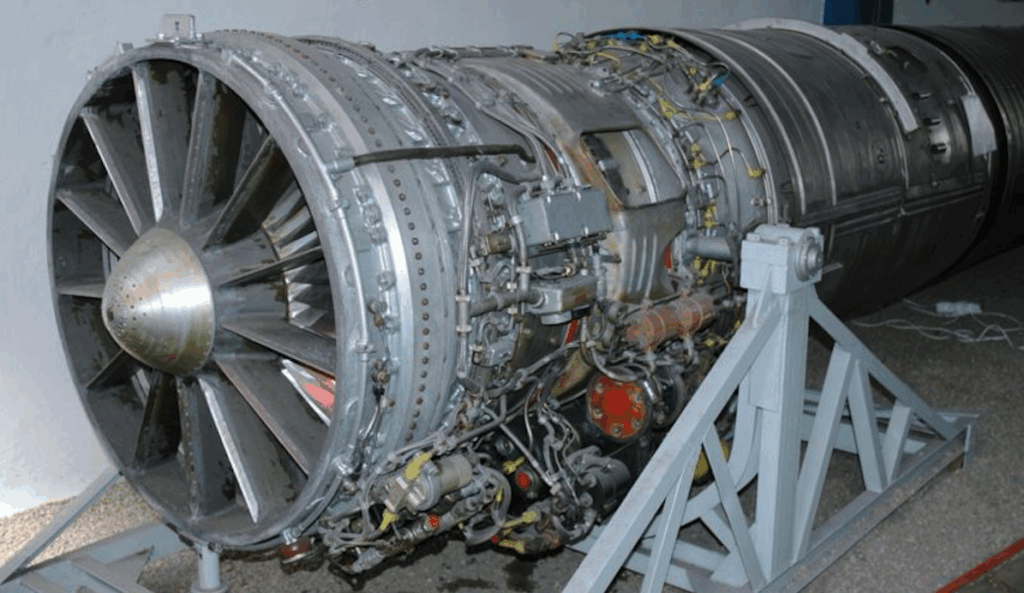
Su-7 BM design.
Single-engine, single-seat, swept-wing mid-wing aircraft. Not equipped with a radar station, but capable of operating in difficult weather conditions. All-metal construction: aluminum and steel.
The wings are of a two-spar construction with two auxiliary spars. The sweep angle of the leading edge is 60 degrees. Mounted at 0 degrees of wedge, they have a negative lift of 2 degrees. The wings are equipped with two-part, single-slotted flaps with a sliding axis of rotation, so-called flap extenders, ailerons and two pairs of aerodynamic guides. Two 30 mm cannons are mounted at the wing base. Fuel tanks are placed in the wings. One armament node is mounted under each wing.
The fuselage of a circular cross-section, starts with a central air intake with a movable cone regulating the air supply to the engine. Single-person cabin. It protrudes from the fuselage outline. It consists of a permanent windshield equipped with three windows, the front bulletproof with a flat pane and a movable fairing moved back manually and equipped with a periscope for observing the rear hemisphere. Fire protection windows were used. A KS-2 type pilot’s seat (Suchowo chair). It certainly saves the pilot from a height of 0 m, but probably from a speed of over 150 km/h. Behind the cockpit there is a compartment for equipment, and further on there are fuel tanks. Finally, the engine was placed. In the rear of the fuselage on the perimeter there are 4 aerodynamic brakes, of a shape similar to a rectangle. In the background of the fuselage there is a place for one braking parachute.
The horizontal plate-type tail, with a sweep angle of 55 degrees and a relative thickness of 6 to 7%. Anti-flutter masses were added at the ends. The tail halves are interchangeable. The vertical tail divided into a rudder and a stabilizer.
Landing gear with a nose wheel. Hydraulically retracted and extended. The front leg is equipped with a vibration damper, which also acts as a steering (steering) system for the wheel. All wheels are single. Oil-pneumatic shock absorbers. The front landing gear retracts towards the front and is covered by two symmetrical flaps. The main one towards the fuselage, mainly to the wings, and only partially to the fuselage. The tires have a relatively large diameter for the possibility of using ground airports and are high-pressure. The main landing gear spacing is 3.83 m.
Equipment of the Su-7 BM.
VHF radio station KSIU, 6-channel. Emergency radio station. Automatic radio compass. Radio beacon receiver. Friend-or-foe SRO-2 M response device. Set of equipment for landing without ground visibility. Siren warning device. Radio rangefinder. Automatic pilot for any speed. ASP-5 ND optical sight coupled or not with a radar rangefinder, with a range of 300 – 3,000 m.
For the pilot, KKO-2 type oxygen equipment used from an altitude of 9,000 m. The oxygen system supplies oxygen to the crew both with a tight and unsealed cabin.
The double hydraulic system is used to move the control surfaces. The third system retracts and extends the landing gear, activates the flaps and controls the nose wheel.
The pneumatic system is used to brake the wheels, reload the guns, seal the cabin, and extend the landing gear in an emergency.
The power source is a generator driven by the engine and batteries. The installation is mainly single-wire DC and AC. It is designed to start the engine, power the fuel pumps, piloting and radio-navigation instruments and the aircraft lighting.
The control of the plate tail, ailerons, and rudder is carried out with assistance in a non-return system and artificial feeling on the control stick. In the plate tail control system, a constant ratio between the stick and the surfaces in the ratio of 4:1 was used. The adopted kinematic system ensures effective control, especially at low altitudes. The directional control system uses the ARZ-1 automatic control unit, which steers the aircraft directionally by automatically deflecting the rudder proportionally to the angular velocity of the deviation.
The Su-7 BM engine.
It is a turbojet, single-flow, single-shaft A. M. Lulki AL.-7 F-1 engine with a thrust of 1 x 68.65 kN. ( 1 x 7,000 kgf. ) with afterburning 1 x 98.10 kN. ( 1 x 10,000 kgf. ). It consists of a 9-stage axial compressor, annular-jug combustion chamber, 2-stage turbine, afterburner and adjustable nozzle. The engine is equipped with an oxygen system to facilitate starting on the ground at low temperatures or high in the air. The fuel system is located in the wings and fuselage and has a capacity of 2,940 liters. It is also possible to suspend 2 fuel tanks with a capacity of 2 x 600 liters under the fuselage or wings.
Initially, the AL.-7 F-1 ( TRD-31 ) engine was used with a thrust of 1 x 66.64 kN. ( 1 x 6,800 kgf. ) with afterburning 1 x 94.08 kN ( 1 x 9,600 kgf. ).
The aircraft can use SPRD-110 powder launch rockets with a thrust of 2 x 29.40 kN (2 x 3,000 kgf).
Su-7 BM armament. Fixed are two NR-30 30 mm cannons. 6 armament nodes (2 under the fuselage and 2 under the wings). The basic combat means are UB-16-57U or UB-32-56U containers with 16 or 32 S-5 57 mm missiles respectively. The machine can take up to 750 kg of bombs. The effects of using the armament are recorded by a camera mounted in the right wing, near the fuselage.
Su-7 BKL version.
Changes compared to the Su-7 BM aircraft. The aerodynamic guides on the wings have been reinforced. Two additional nodes with a lifting capacity of 2 x 250 kg have appeared under the wings, installed since 1969. A new KS-4 ejection seat of class 0-140 has been used in the cockpit. The front armored window is slightly thinner to improve visibility. The internal fuel supply has been slightly increased. The air brakes have been strengthened. The vertical tail has been slightly redesigned and reinforced. The landing gear has received a system with amphibians. Landing is now supported by two braking parachutes, not one. They are placed in a container at the base of the vertical tail.
Su-7 BKL engine. The powerplant is the AL.-7 F-1-250 engine, the service life of which has been extended to 250 hours. The weight is 2,103 kg. Fuel consumption is 0.9 kg/kg/h. The powerplant is supported by SPRD-110 take-off boosters with a thrust of 2 x 29.40 kN (2 x 2,998 kg), but their thrust depends on the outside temperature and humidity.
Su-7 BKL equipment. ASP-PF-7 semi-automatic sight, which was replaced in the 70s by the newer ASP-PFM-7. The aircraft now has 6 armament nodes in a 2 x 2 x 2 configuration. The aircraft can carry additional fuel tanks with a capacity of 950 liters on internal nodes under the wings. Theoretically, for ferrying, the aircraft can take 3,955 liters in the fuselage + 3,100 liters in 4 tanks under the fuselage, which gives a total of 7,055 liters. There are some restrictions in use; the aircraft can take either only missiles or only bombs, since the same electrical connections are used. In the 70s, a new launcher for S-5 missiles was introduced, it was the UB-32A-72 with 32 guides.
Also in the 70s, all versions of the Su-7 were adapted to carry under-wing jamming pods of the SPS-141, SPS-142 and SPS-143 type, depending on the expected jamming frequency.
Design of the Su-7 U.
The main difference is the use of a two-person cabin in a tandem configuration. The fuselage is 0.20 m longer. A superstructure was placed on the fuselage, in which equipment moved from behind the pilot’s cockpit was placed. Despite the reconstruction of the fuselage fuel tanks, its amount is almost identical to that of the Su-7 BM version.
Individual cockpit covers are raised upwards to the rear pneumatically. The rear cockpit is equipped with a folding periscope. Its mirrors are made of polished metal. The periscope can be used at speeds of up to 600 km/h. (The reinforced version of the periscope is used at speeds of up to 850 km/h).
The crew received a special version of the KS-4 U-22 ejection seats; the pilot’s seat was always deployed first, followed immediately by the instructor’s, regardless of who initiated the exit from the aircraft.
The landing gear (often treated badly by young pilots, especially during landings) and its brakes were strengthened. The front landing gear leg was equipped with brakes and could be controlled hydraulically. The landing gear braking system received an installation spraying the wheel hubs with alcohol, cooling them more effectively.
The increase in the weight of the entire aircraft caused restrictions in the carried armament, the maximum load capacity of the suspensions was limited to 2,500 kg, some machines did not receive the left-wing 30 mm cannon. However, the possibility of carrying nuclear bombs was retained. The sight used on the training aircraft is a modification from the S-7 BM designated as ASP-5ND-7U, replaced from the 12th production series by the newer ASP-PF-7U.
T-T data of Su-7 B aircraft.
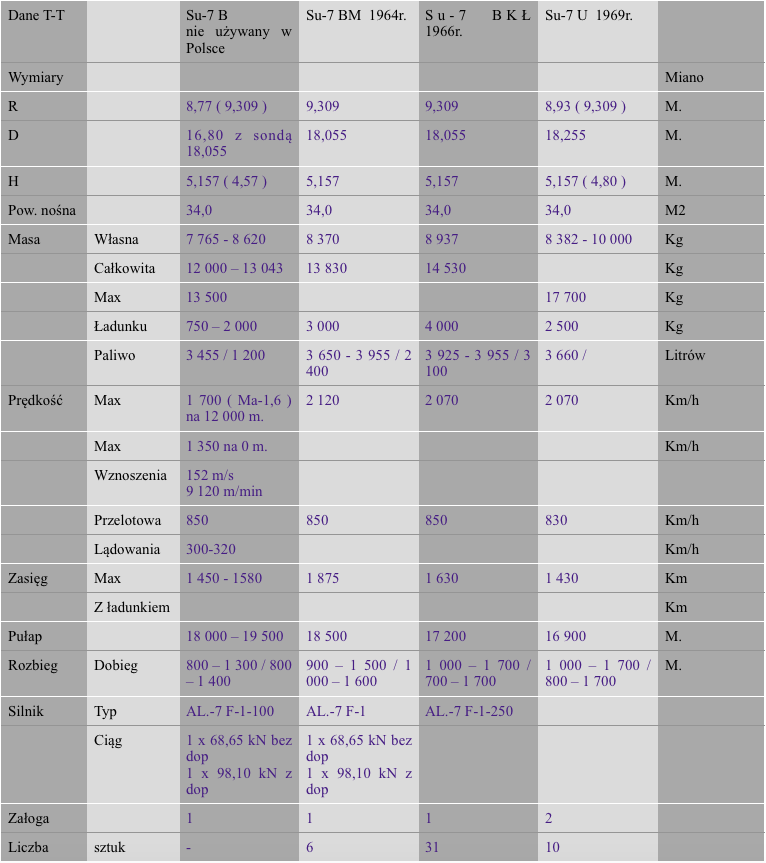
Written by Karol Placha Hetman

